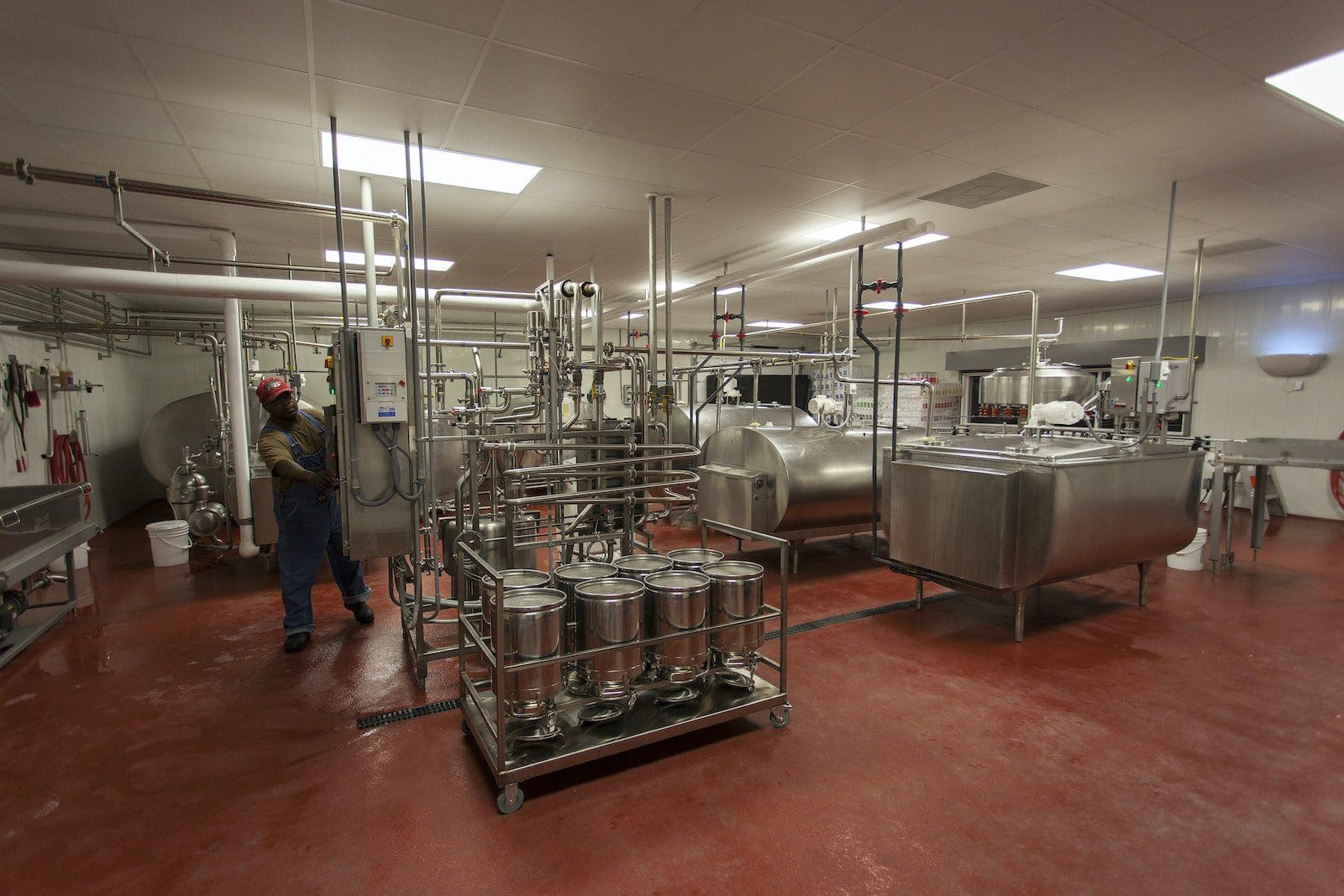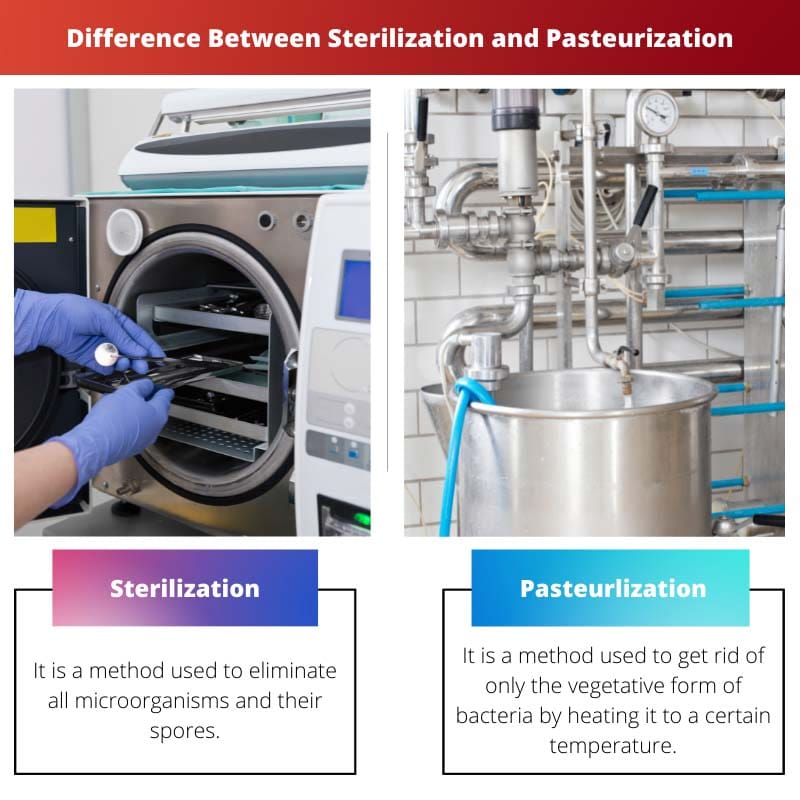A microorganism, a microbe, is an organism only visible through a microscope. Such microorganisms may be either unicellular, multicellular, or cell clusters.
There are infinite microorganisms in existence. They can be broadly divided into seven categories: fungi, algae, bacteria, protozoa, archaea, viruses, and animal parasites.
Some are beneficial for everyday life as they produce oxygen, maintain human health and provide nutrients for plants as they help decompose organic material. In contrast, some microorganisms may cause harm as they spread diseases.
Several methods are used to kill harmful microorganisms. Two standard methods used are sterilization and pasteurization.
Key Takeaways
- Sterilization eliminates all microorganisms, including spores, through autoclaving, dry heat, or radiation.
- Pasteurization reduces the number of harmful microorganisms using controlled heat without destroying the product’s properties.
- Sterilization is essential for medical instruments and pharmaceuticals, while pasteurization is commonly used in food and beverage processing.
Sterilization vs Pasteurization
Sterilization is a process of killing microorganisms by exposing them to high temperatures, pressure, or chemicals. Pasteurization is a process of heating a substance to a specific temperature to reduce the number of harmful microorganisms present. It is used to reduce the risk of foodborne illness.

Comparison Table
| Parameters of Comparison | Sterilization | Pasteurization |
|---|---|---|
| Definition | It is a method used to eliminate all microorganisms and their spores. | It is a method used to eliminate only the vegetative form of bacteria by heating it to a specific temperature. |
| Types | Sterilization can be both physical and chemical. Physical sterilization means sterilization with heat or even cold sterilization. Chemical sterilization means gas sterilization using chemical agents or cold sterilization. | Pasteurization depends on temperature and can be vat pasteurization, HHST, or HTST. |
| Effect | This method kills all microorganisms, including vegetative and spores forms. | This method eliminates only the vegetative forms of bacteria. |
| Usage | Sterilization is used in microbiology, the food industry, the packaging industry, etc. | Pasteurization is used in medicines, culture mediums, etc. It is used in food preservation methods in the food industry. |
| Period of validity | The period of validity for sterilized products is longer than for pasteurization products. | The validity period of pasteurized products is shorter than that of sterilization products. |
What is Sterilization?
Sterilization is the method that is used for the destruction of all microorganisms and their spores. This method eliminates pathogenic and saprophytic microorganisms.
It also destroys vegetative and spores forms of bacteria in fresh foods.
The sterilization process may be of 2 types: physical or chemical.
Physical sterilization includes sterilization with heat or cold sterilization.
Further, sterilization with heat may be wet or dry. Dry heat sterilization uses hot air, whereas wet heat sterilization uses water vapour. When the temperature rises above a certain level, the microorganisms die.
The weakest forms are the vegetative forms of bacteria. They are not much resistant to heat and hence die quickly. Next are the moulds and viruses, which are somewhat heat resistant, and the most resistant spores.
Cold sterilization is performed using radiation or bacterial filters. There are different types of radiation used for cold sterilization. They may be ultrasound, ionizing rays, or non-ionizing ultraviolet radiation.
On the other hand, chemical sterilisation includes Cold chemical sterilization and Gas sterilization with chemical agents.
Chemical sterilization is possible with alcohol, surfactants, aldehydes, oxidants, phenol derivatives, acids and bases, halogen preparations, combined preparations, etc.

What is Pasteurization?
Pasteurization is a method used to eliminate the vegetative form of bacteria only by heating it to a certain temperature for a specific period.
Here, the spores live. It is necessary to store the products in a refrigerator after pasteurization to stop the growth of the saprophytic bacteria that survived.
For different purposes, different pasteurization processes are used. The type of pasteurized product, its purpose, its volume, the availability of the equipment, and the microorganisms targeted are what the choice of pasteurization methods depends on.
Vat pasteurization, HHST, and HTST are different pasteurization methods depending on the time and temperature.
It can be said that Vat pasteurization is primarily used in the food industry. It focuses on destroying pathogenic microorganisms. It also aims at improving the products’ shelf life.
It conserves almost all the physicochemical values of food products. Vat pasteurization is also used to manufacture beer, milk, etc.
High-temperature pasteurization focuses on destroying the vegetative pathogen. It changes the serum proteins and is used to manufacture yoghurt, cheese, etc.
Repeating sterilisation makes it possible to acquire a wholly pure and clean product. It is used in the treatment and care of medicines, where it is implemented for 30 minutes for many days at 100 degrees Celsius temperature.

Main Differences Between Sterilization and Pasteurization
- Sterilization is a method used to eliminate all microorganisms and their spores. In contrast, Pasteurization is the process that helps to kill only the vegetative form of bacteria, but the spores live.
- The result of Sterilization is that it kills all microorganisms, vegetative and spores forms. The effect of Pasteurization is that it kills only the vegetative forms of bacteria.
- The shelf life of sterilization products is longer than pasteurized products, which are shorter.
- There are two types of sterilization, physical and chemical. Physical sterilization is sterilization with heat or even cold sterilization. Chemical sterilization is gas sterilization using chemical agents or cold sterilization. Pasteurization depends on temperature and can be vat pasteurization, HHST, or HTST.
- Microbiology, the food industry, the packaging industry, etc., use sterilization. On the other hand, pasteurisation is used in medicines, culture mediums, etc. Also, it is used in the food industry for food preservation methods.


The article offers a comprehensive comparison of sterilization and pasteurization. However, a futuristic outlook on the potential advancements in these methods would provide a stimulating conclusion to the content.
Francesca, I echo your sentiment. Including future trends would give the readers an intriguing perspective to reflect upon.
Well said, Francesca. A forward-thinking perspective would certainly leave the readers pondering over the implications of future technological progress in sterilization and pasteurization.
The information about sterilization and pasteurization is crucial for maintaining public health. However, it would be more compelling if real-world examples were provided to illustrate the applications of these methods.
Sienna, I couldn’t agree more. Incorporating practical instances would make the content more relatable and engaging.
Absolutely right, Sienna. Real-world case studies could augment the practical understanding of sterilization and pasteurization.
This article succeeds in explaining the fundamental concepts of sterilization and pasteurization. However, a historical context showcasing the evolution of these processes over time would add an intriguing narrative layer to the content.
Lilly, your point about historical context is insightful. A historical perspective could provide a captivating backdrop to the subject matter.
I agree with you, Lilly. Tracing the historical development of sterilization and pasteurization would indeed make the article more compelling.
The details on sterilization and pasteurization are highly informative. However, I believe the article could delve deeper into the specific applications of these methods in different industries.
Absolutely, Ellis. Understanding how these processes are employed across various sectors would enhance the value of this article.
I concur. A more industry-specific approach to sterilization and pasteurization would be intriguing.
The classical descriptions of sterilization and pasteurization in this article are commendable. However, delving into the ecological implications of these processes would round out the content quite well.
David, I resonate with your viewpoint. Exploring the environmental ramifications of sterilization and pasteurization would present a holistic perspective.
The comparison between sterilization and pasteurization offers valuable insights. However, I believe a broader examination of emerging technologies in these fields would enhance the content.
You’re absolutely right, Tim. A futuristic perspective on these methods could further enrich the discussion.
I see your point, Tim. Exploring the advancements in sterilization and pasteurization would be thought-provoking.
The differentiation between sterilization and pasteurization is well-articulated here. However, a more detailed focus on the potential shortcomings of these processes would make for a more balanced read.
Well said, Elliott. Providing a critical analysis of the drawbacks associated with sterilization and pasteurization would offer a more nuanced understanding.
Elliott, I completely agree. Acknowledging the limitations of these methods would present a more comprehensive view of the subject.
The classification of microorganisms discussed here is quite enlightening. However, I would’ve appreciated a more in-depth comparison between sterilization and pasteurization.
I share your thoughts, Lsaunders. Further information on the differences between sterilization and pasteurization would be beneficial.
Agreed. This article provides a starting point, but a more thorough analysis would be valuable.
The elucidation of sterilization and pasteurization is indeed enriching. Nevertheless, embedding a discussion on societal implications and ethical considerations associated with these techniques would further elevate the article’s depth.
Frank, I couldn’t agree more. Considering the broader societal and ethical dimensions would undoubtedly enhance the article’s relevance.
Absolutely right, Frank. Addressing the ethical and societal aspects of sterilization and pasteurization would make the content more thought-provoking.
Microorganisms can be fascinating creatures. The vast diversity among them makes them essential for the equilibrium of life on Earth. This article does an excellent job of explaining the importance of sterilization and pasteurization in the control of harmful microorganisms.
I couldn’t agree more with your assessment, Harrison.
Indeed, this article provides a comprehensive understanding of how essential these processes are for ensuring safety in various industries.